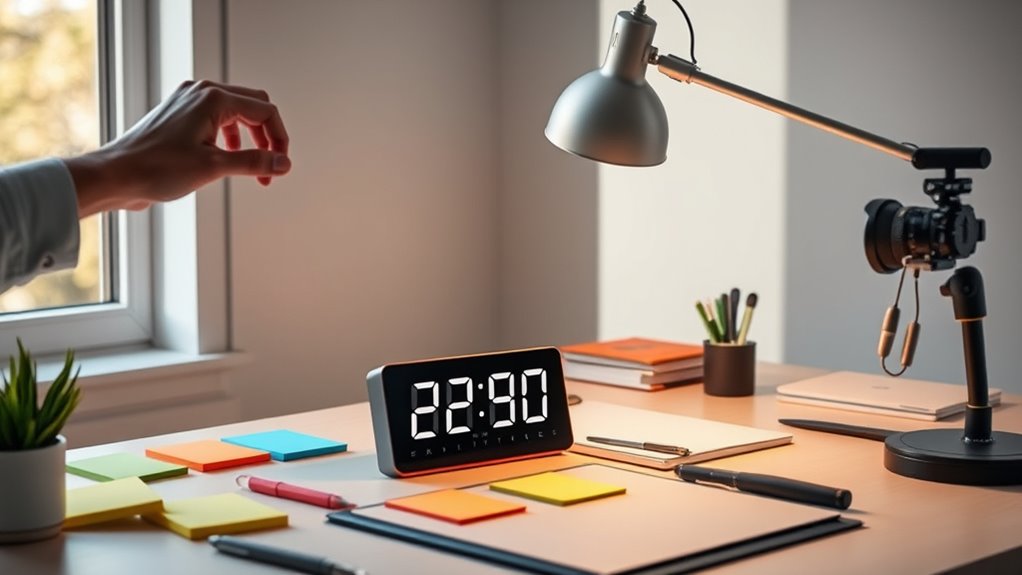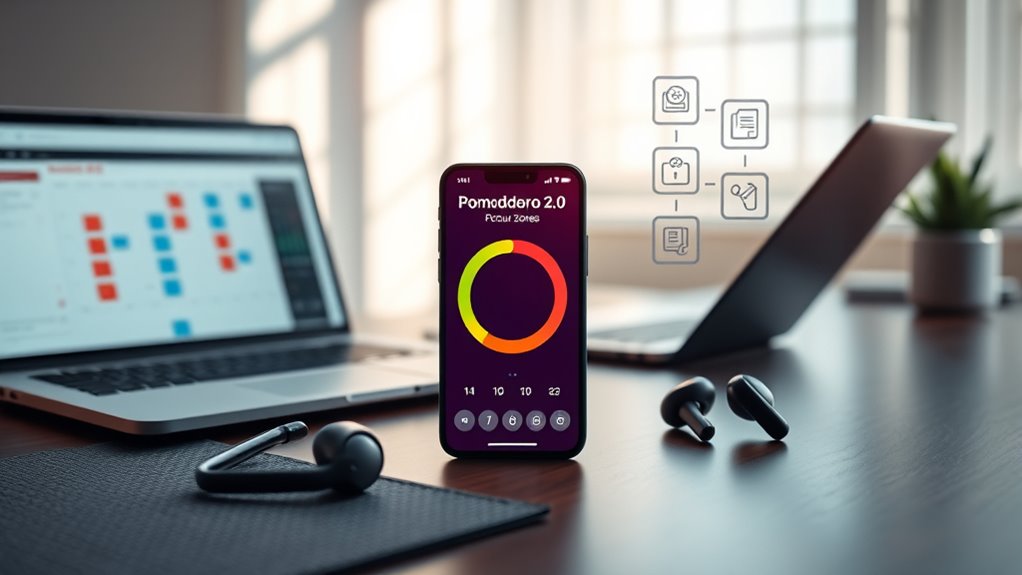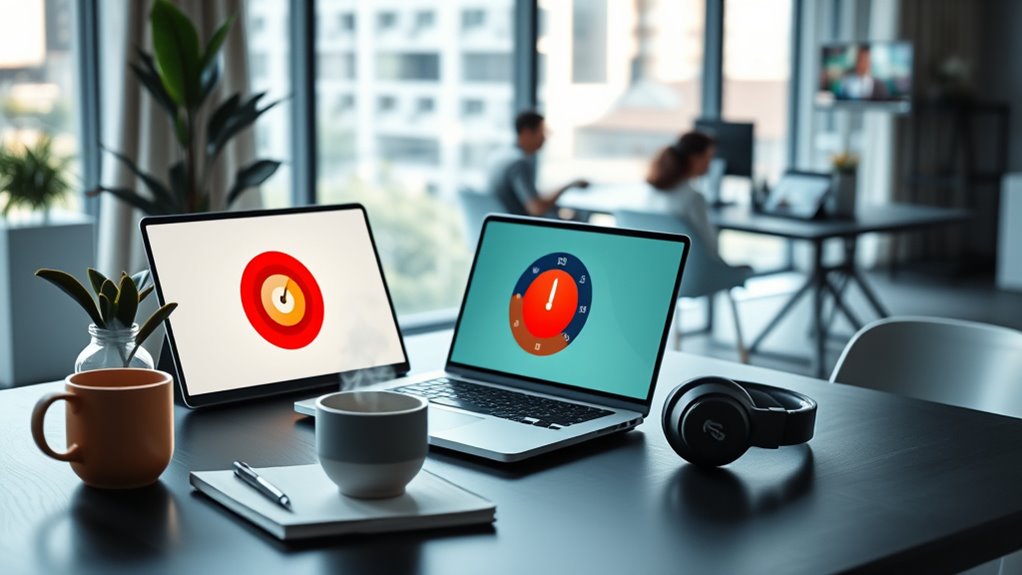Pomodoro 2.0 is a flexible and personalized focus method ideal for 2025. Instead of strict timers, you adjust session lengths, incorporate mindfulness, and create rituals to shift smoothly between work and breaks. Its adaptability supports remote and hybrid setups, emphasizing your environment and habits. By tailoring focus and break activities, you boost productivity and well-being. If you want to explore how to make this approach work for you, there’s more insights ahead.
Key Takeaways
- Pomodoro 2.0 emphasizes flexibility, allowing users to customize session lengths and break activities based on personal needs.
- It integrates mindfulness and ergonomic practices to enhance focus and reduce stress during work cycles.
- Digital tools like Focus Booster and Forest support personalized timers, analytics, and gamified focus experiences.
- Environmental and lifestyle factors, such as workspace setup and break activities, are central to maintaining sustainable focus.
- Future trends include AI-driven time blocking, virtual reality integration, and digital detox strategies for improved productivity in 2025.
Understanding the Origins of the Pomodoro Technique

Have you ever wondered where the Pomodoro Technique came from? Its history evolution traces back to the late 1980s when Francesco Cirillo developed the method. Inspired by a kitchen timer shaped like a tomato (pomodoro in Italian), he wanted a way to boost his focus and productivity. Cirillo’s founder insights reveal that he aimed to create simple, effective time management strategies that could fit into daily routines. Over time, the technique gained popularity among students and professionals alike. Its core idea—working in focused intervals followed by short breaks—remains consistent today. Understanding this origin helps you appreciate the method’s simplicity and adaptability. The history evolution underscores how a small, innovative idea can transform into a global productivity tool used worldwide. Additionally, the development of the technique was influenced by time management principles and the desire for efficient work cycles.
Limitations of the Classic Method in Modern Settings

While the Pomodoro Technique was innovative for its time, it faces challenges when applied to today’s complex work environments. Rigid 25-minute intervals can disrupt deep focus or creative flow, especially when tasks require longer periods of concentration. Additionally, the strict timing may hinder your mental health, causing stress or frustration if you feel pressured to break or resume work unexpectedly. Social interactions also suffer, as the method discourages multitasking or collaborative discussions during work sprints. In modern settings, flexibility often outweighs strict time blocks, making the classic Pomodoro less effective for maintaining overall well-being and fostering team communication. To stay productive without compromising your mental health or social connections, you need a more adaptable approach—enter Pomodoro 2.0.
The Core Principles Behind Pomodoro 2.0

Recognizing the limitations of the traditional Pomodoro Technique, Pomodoro 2.0 centers on flexibility and adaptability as its core principles. Instead of rigid timers, you embrace mindful awareness, integrating mindfulness meditation to gauge your focus and energy levels. This approach encourages you to listen to your body’s signals, adjusting work and break periods as needed. Creating an ergonomic workspace supports sustained concentration and reduces fatigue, aligning with the core idea of working smarter, not harder. Flexibility means you’re not bound by strict intervals but instead tailor sessions to your natural flow. This shift helps you stay engaged and productive while maintaining well-being. By prioritizing mindfulness and ergonomic habits, Pomodoro 2.0 fosters a sustainable, personalized focus strategy for the modern workspace.
Customization and Flexibility in Focus Sessions

Customization and flexibility empower you to tailor focus sessions to your unique rhythms and tasks. With a variety of personalization options, you can adjust session lengths, break intervals, and task priorities to suit your workflow. Flexibility techniques allow you to modify the traditional Pomodoro structure, making it more adaptable to your day. For example:
| Focus Mode | Duration | Break Options |
|---|---|---|
| Standard | 25 mins | 5-min microbreak |
| Extended | 50 mins | 10-min longer break |
| Adaptive | Varies | Custom break times |
This approach helps you stay engaged and productive without feeling constrained. By customizing your focus sessions, you optimize your efficiency and maintain motivation throughout the day. Additionally, understanding diverse beach experiences can inspire you to incorporate relaxing breaks into your routine, enhancing overall productivity and well-being. Recognizing the importance of home organization can further support your focus by creating an environment that reduces distractions and promotes clarity. Proper bedroom decor can also contribute to a calming atmosphere, making it easier to transition into focused work sessions.
Integrating Breaks and Mindful Transitions

To make your breaks more effective, try incorporating mindful strategies that reset your focus. Establish shift rituals, like stretching or deep breathing, to smoothly shift between work and rest. These small habits can enhance your overall productivity and help maintain mental clarity throughout your sessions. Additionally, cultivating a calm mindset during transitions can support sustained focus and reduce stress.
Mindful Break Strategies
Incorporating mindful break strategies into your routine can substantially boost focus and reduce burnout. During breaks, focus on mindful breathing to center yourself and clear mental clutter. This simple practice helps you reconnect with the present moment, reducing stress and enhancing clarity. Ensure your workspace is ergonomic, allowing you to stretch and move comfortably without strain. Use your break time to step away from screens, adopt a relaxed posture, and breathe deeply, fostering a sense of calm. These mindful pauses not only refresh your mind but also improve your posture and overall comfort. Be mindful of distraction cues during your breaks to maintain your focus and prevent slipping back into unproductive habits. Recognizing the importance of ergonomics can help you optimize your workspace for better comfort and productivity. Additionally, paying attention to emotional well-being during these moments can further support your overall mental health. Incorporating headphone use with comfortable, ergonomic headphones can also help you create a dedicated focus environment and block out distractions. By intentionally integrating mindful breathing and ergonomic awareness into your breaks, you create a sustainable rhythm that maintains your focus and promotes well-being throughout your workday.
Transition Rituals for Focus
Change rituals serve as essential cues that signal the end of one focused work session and the beginning of a mindful break, helping your mind shift smoothly between tasks. Incorporating mindful routines and ritualistic habits into your progressions creates clear boundaries, reducing mental clutter and enhancing focus. For example, you might take a few deep breaths, stretch, or close your eyes briefly before starting your break. These intentional actions reinforce a sense of closure and renewal, making it easier to detach from work and reset. Additionally, establishing specific transition times can help align your focus with Parks and Entertainment schedules, ensuring your breaks feel intentional and refreshing. Recognizing the importance of mindful routines in promoting mental clarity can further deepen your focus habits. By integrating simple, mindful routines, you establish a rhythm that promotes sustained focus and mental clarity throughout your day. Incorporating these rituals can also help manage your work environment more effectively, creating a seamless flow between work and relaxation.
Tools and Apps Supporting Pomodoro 2.0

With the rise of digital productivity tools, supporting Pomodoro 2.0 has become easier than ever. These apps help you manage focus sessions while promoting a digital detox, reducing screen fatigue. Many tools also guide you in creating an ergonomic setup, encouraging proper posture during work. Here’s a quick look at some popular options:
| Tool/App | Features | Best For |
|---|---|---|
| Focus Booster | Customizable timers, analytics | Flexibility in sessions |
| Be Focused | Task integration, break reminders | Task management |
| TomatoTimer | Simple interface, quick starts | Quick setup |
| Forest | Focus with virtual tree planting | Gamified focus |
| Endel | Focus music, ambient sounds | Enhancing concentration |
Supporting your workflow with these apps can also promote proper posture, which is essential for avoiding discomfort during extended work sessions. Additionally, paying attention to content quality helps maintain motivation and reduces fatigue by making work sessions more engaging.
Adapting Pomodoro 2.0 for Remote and Hybrid Work

When working remotely or in hybrid settings, managing distractions becomes even more vital. You’ll need to tailor your breaks to refresh effectively without losing focus. Incorporating exfoliation benefits and composition techniques can help create an inspiring workspace atmosphere that boosts concentration and motivation.
Managing Distractions Remotely
Managing distractions remotely requires intentional strategies, especially as your environment becomes more unpredictable. To stay focused, create boundaries that support your digital minimalism and ergonomic workspace.
Consider these steps:
- Designate a dedicated workspace free from clutter and interruptions.
- Limit notifications by turning off non-essential alerts during work sessions.
- Use digital minimalism principles to streamline your apps and tools, reducing chaos.
- Set clear boundaries with family or housemates to protect your focus periods.
Customizing Breaks Effectively
Adapting your breaks in Pomodoro 2.0 is essential for maintaining productivity in remote and hybrid work setups. To optimize your break duration, vary your activities to keep your mind fresh. Shorter breaks of 5 minutes work well for quick refreshers, while longer breaks of 10-15 minutes help you recharge fully. Incorporate activity variety by switching between physical movement, stretching, or a quick walk, and mental resets like mindfulness or a snack. Use this table to customize your breaks:
| Break Duration | Suggested Activities |
|---|---|
| 5 minutes | Stretching, quick walk |
| 10 minutes | Meditation, light exercise |
| 15 minutes | Snack, social check-in |
| 20 minutes | Power nap, creative activity |
Tailor your breaks to stay energized and focused throughout your workday.
Strategies for Maintaining Motivation and Focus

Maintaining motivation and focus can be challenging, especially during long work sessions or repetitive tasks. To stay on track, you need effective motivation strategies and focus techniques. Here are four ways to boost your concentration:
- Break tasks into smaller, manageable chunks to prevent overwhelm.
- Use visual cues or timers to create a sense of urgency and accountability.
- Celebrate small wins to reinforce your motivation.
- Incorporate short, intentional breaks to recharge without losing momentum.
These strategies help keep your energy high and your mind engaged, making it easier to sustain attention. By applying these motivation strategies and focus techniques, you’ll find it easier to stay productive and motivated throughout your work sessions.
Tracking Progress and Adjusting Your Approach

Tracking your progress is essential to understanding how well your strategies are working and identifying areas for improvement. By regularly monitoring your progress tracking, you can see which techniques boost focus and which hinder productivity. When you notice consistent patterns, you can make informed approach adjustments to optimize your workflow. Use the table below to evaluate different aspects of your focus sessions:
| Aspect | Observation | Action Needed |
|---|---|---|
| Session Length | Are sessions too long or short? | Adjust duration for better focus |
| Break Timing | Are breaks invigorating? | Modify break intervals |
| Distractions Level | Are interruptions frequent? | Minimize external disruptions |
| Task Completion Rate | Are tasks completed efficiently? | Refine task prioritization |
Regularly updating this info helps you fine-tune your focus approach for maximum productivity.
Future Trends and Innovations in Time Management

As technology continues to evolve, innovative tools and methods are shaping the future of time management. Expect a stronger focus on digital detox strategies to reduce screen fatigue and improve focus. Time blocking will become more personalized, integrating AI suggestions to optimize your schedule. Smart apps will monitor your productivity patterns, recommending when to take breaks or switch tasks. Additionally, immersive technologies like virtual and augmented reality will help create distraction-free environments, boosting concentration. These trends encourage you to adopt flexible routines, blending traditional techniques like Pomodoro 2.0 with new innovations. By embracing digital detox and refining your time blocking, you’ll stay ahead in managing your time effectively, ensuring sustained productivity and well-being in 2025 and beyond.
Frequently Asked Questions
How Does Pomodoro 2.0 Differ From Other Focus Techniques?
You’ll find that Pomodoro 2.0 differs from other focus techniques by offering time flexibility and adaptive intervals. Unlike rigid methods, it adjusts session lengths based on your workload and energy levels, helping you stay focused longer without burnout. This personalized approach makes it more effective, allowing you to tailor your work periods and breaks, ultimately boosting productivity and maintaining motivation throughout your day.
Can Pomodoro 2.0 Be Integrated With Existing Productivity Systems?
You can definitely integrate Pomodoro 2.0 with your existing productivity systems, but watch out for integration challenges like compatibility issues. To overcome these, use compatibility strategies such as customizing timers or syncing apps to match your workflow. This way, you maintain consistency and maximize focus. With some adjustments, Pomodoro 2.0 enhances your system without disrupting your established routines, making your productivity more flexible and effective.
What Are the Common Challenges When Adopting Pomodoro 2.0?
When adopting a new focus technique, you may face challenges like managing distractions and adjusting to different time blocks. You might find it hard to stay disciplined or to adapt the method to your unique work rhythm. Balancing focus with flexibility requires practice, but once you master distraction management and time adaptability, you’ll boost productivity and sustain motivation more effectively. Embrace these challenges as part of your growth process.
How Does Pomodoro 2.0 Support Mental Health and Well-Being?
You can boost your mental health and well-being by using Pomodoro 2.0, which encourages mindfulness practices during breaks. It helps you manage stress reduction by promoting focused work intervals and intentional pauses, allowing you to reset mentally. This technique supports better work-life balance, reduces burnout, and fosters a sense of control and calm. By integrating mindful pauses, you stay present and attentive, improving overall emotional resilience.
Are There Specific Industries Where Pomodoro 2.0 Is Most Effective?
You’ll find that Pomodoro 2.0 works best in industries where focus and time management are vital, like tech, creative fields, or customer service. Its industry-specific adaptations help you tailor work sessions and breaks, boosting sector-focused effectiveness. By adjusting intervals to suit your industry’s pace, you stay productive without burnout, making it a versatile tool across various sectors that demand high concentration and flexibility.
Conclusion
Embracing Pomodoro 2.0 means you’re tailoring your focus to fit 2025’s dynamic work landscape. Its flexibility lets you stay productive without burning out, just like the saying goes, “Variety is the spice of life.” By customizing sessions, integrating mindful breaks, and tracking progress, you’ll find a rhythm that keeps you motivated. Remember, the key to success is adapting tools to serve you—because the only constant is change.









